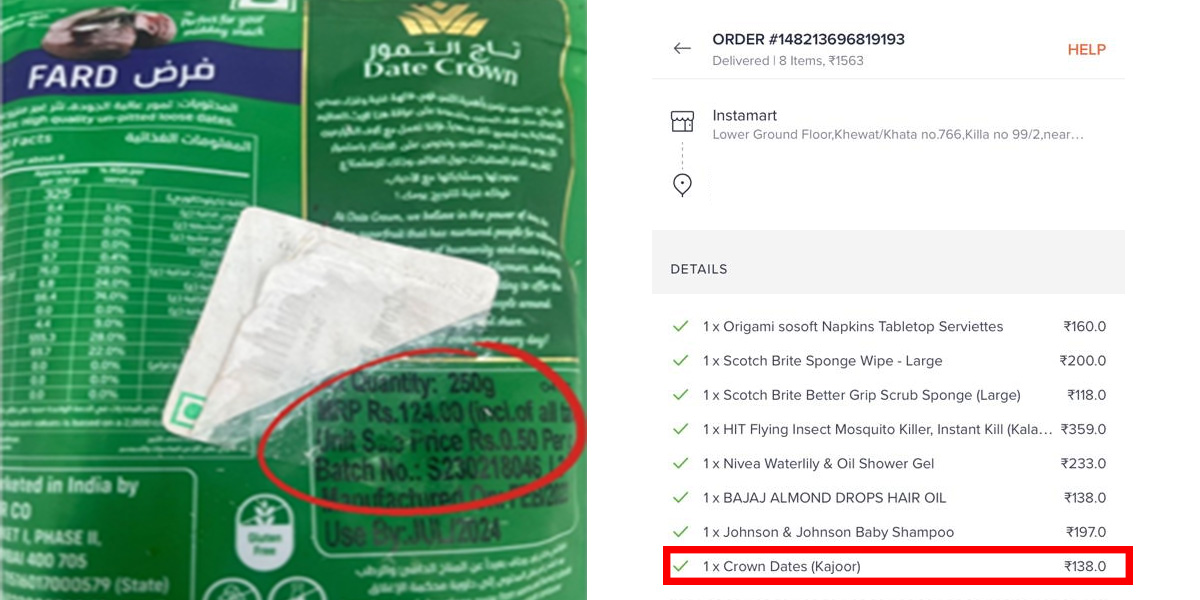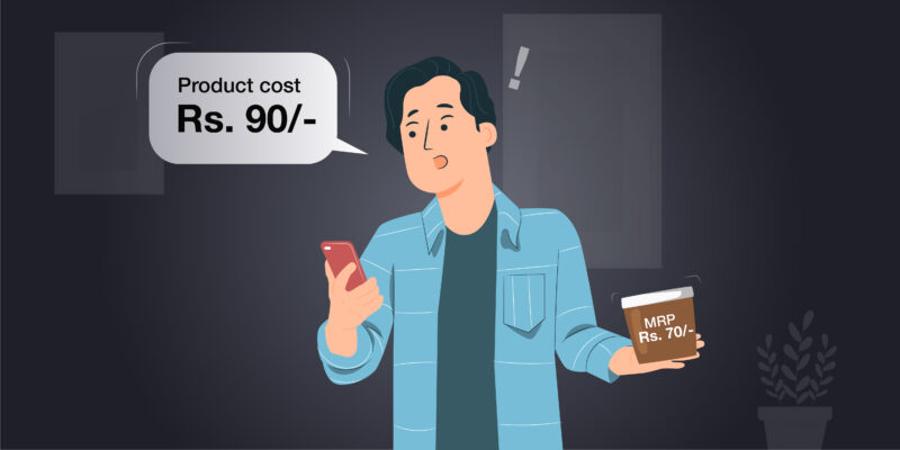Early June, a Swiggy Instamart user from Uttar Pradesh tagged the company on Twitter complaining about charging customers higher than the MRP. Case in point was a product whose MRP was Rs 125, but the customer was charged 10 rupees higher. “Is it legal to charge more than the MRP? Ordered groceries from Instamart and Swiggy charged me more than the MRP of the product,” the customer tweeted, with images attached as proof.
Some days later, Ram Singh, a regular Blinkit user noticed the product he received had an MRP of Rs 240 on the packaging while he had had to pay 34 rupees extra, per the price listed on the platform. Singh experienced the price discrepancy with three different products.
Last December, a Zepto user from Bengaluru received a product with an MRP of Rs 99 printed on the packaging but paid Rs 113, including a discount via the platform.
Another regular customer of Instamart user from Tamil Nadu noticed a Rs 100 difference in a bottle of coffee ordered. “I felt like I was scammed but this incident helped me be more cautious. I definitely lost trust in the platform,” Sirsh Gautam told Entrackr.
The price disparity was seen in products ranging from milk, fresh cream, and flour to hand wash refills, face washes, and cooking oil. The extra amount in all these cases was excluding the delivery charge and handling fee.
These aren’t isolated cases. Numerous such complaints have been posted across various social media platforms where customers are demanding Blinkit, Instamart, Zepto, and BigBasket to explain the price gap. Entrackr spoke to over half a dozen such users who have complained to the respective platforms. Few were met with a refund from the platform while the others have been denied.
Queries sent to Instamart, BigBasket, and Zepto did not elicit a response at the time of publishing this story.
A Blinkit spokesperson said there were a “negligible” number of such cases across the country during a month where the company “inadvertently” delivered a different batch of the product. They further added, “As a protocol, we immediately refund the balance amount to our users. Having said that, we are continuously working with sellers and brands to further reduce the frequency of such cases.”
Maximum Retail Price commonly known as MRP is the highest price at which a product can be sold. It is inclusive of all manufacturing charges, marketing expenses, profit margin and taxes. The MRP is set by the manufacturers of the product and cannot be influenced by third-party e-commerce marketplaces. In India, the sale of a product above its set MRP is deemed illegal.
Stella Joseph, a partner at Economic Laws Practice told Entrackr that as per The Legal Metrology (Pre-Packed Commodities) Rules, 2011, “no retail dealer or other person including manufacturer, packer, importer and wholesale dealer shall make any sale of any commodity in packed form at a price exceeding the retail sale price.”
This essentially means no seller can sell or quote a price of a product exceeding the MRP printed on it. If such a situation were to occur, the individual or company responsible for making the sale is liable to a fine of up to Rs 25,000 for the first offense. The fine can increase up to Rs 50,000 for the second recorded offense and subsequent offenses can attract a fine of up to Rs 1 lakh or imprisonment for one year or both.
To test the frequency of this problem, Entrackr tried using two such platforms. Of the five orders, two orders showed the discrepancy customers were complaining about. In the first case, a pack of dates was listed at Rs 138, but the printed MRP was Rs 124 and in the second case, the pair of chocolate boxes was listed at Rs 90 but totalled Rs 80 according to the MRP printed on the products.

Upon further research, Entrackr found that such an issue occurred with items that were manufactured at an earlier date but saw an increase in MRP while being produced later. The pictures users had attached along with their complaints showed that there was a difference in the manufacturing date of the products. In this case, it would mean that a bottle of coffee powder manufactured in June 2022 was priced at Rs 295 while the same item produced in December 2022 had the MRP set at Rs 320.
It seems that the platform had listed older products like the coffee powder manufactured in June at the new MRP rate. This means the product that was manufactured at a rate of Rs 295 is being listed and sold at Rs 320.
Most users with a similar complaint were receiving products manufactured at a date before when the MRP was changed to a higher price.

Joseph mentioned this issue comes under a gray area and there aren’t exact rules established around dealing with such a scenario. But there are regulations around the information e-commerce companies are mandated to put up on their sites. As per the PCR rule 6(10), Joseph said, “The e-commerce website is required to ensure that all mandatory details which are to be made on the package of the commodity, apart from the month and year of manufacture, are displayed on the website as well.”
MRP comes under the list of details to be mandatorily mentioned on the site.
This is a practice often avoided by various e-commerce websites. Platforms are seen to crop out certain information while displaying the pictures of the product or editing out the MRP and manufacturing dates. The Legal Metrology Act, of 2009 clearly states that a new MRP cannot be put over the older printed price.
If an e-commerce website does not show the MRP of a product on its website but displays an alternate price while misleading the public as regards the price at which the product is ordinarily sold, the situation may be evaluated from the perspective of whether it constitutes as an unfair trade practice as per The Consumer Protection Act, 2019.
The lack of steady laws and regulations regarding how a company or e-commerce platform should deal with a situation where the MRP of a product has been increased is proving to be detrimental. While the customers are left feeling deceived, the company too struggles to navigate its way through this change. This disparity could be strongly questioned by customers seeing as they have received products that have a different MRP as stated on the site.
Industry experts explain that when a company increases the MRP of a product, there are very slight changes made to the product in order to justify the price increase. “A lot of times the price fluctuation does not happen in the same SKU [stock keeping unit], but [in] a very similar SKU for example there is an increase in a variation of the grammage of the product,” said Prerna Kalra, e-commerce expert and CEO & co-founder of Daalchini Technologies, a company that makes smart vending machines.
Kalra’s company handles such a situation by launching the product with the new MRP with a downtime. “Basically, if there is a product which is already there in the supply chain then a similar product or same product with higher MRP is not introduced into the supply chain with an immediate effect,” she added.
Other ways to deal with this include bundling the old inventory in offers, or removing it from circulation altogether, said Vishal Jain, co-founder of logistics startup Roadcast.
When getting rid of inventory doesn’t work, technology can come to the rescue. Varun Tangri, CEO and founder of mobile PoS application provider QueueBuster explains that with the “right technology” and an “effective inventory management software,” such situations can be fixed. “At the back end, you can update identical products but with different MRP in different batches. And while following the FIFO [first in first out] method, you can decide which batch to use when invoicing and delivering the product.”
Meanwhile, there are ways customers can deal with such scenarios. The E-Commerce Rules make it mandatory for every e-commerce entity to appoint a nodal grievance officer, whose designation and contact information must be displayed on its website. The appointed officer is required to acknowledge the receipt of the complaint in 48 hours and redress the complaint within one month from the receipt date.
The aggrieved customers may also file a complaint before the established hierarchy of courts, i.e. District Commission at the district level, a State Commission at the state capital and the National Commission at New Delhi, depending upon their pecuniary jurisdiction.
Update: A Swiggy Instamart spokesperson reached out to Entrackr after the story was published. They said, “There are very rare cases where the MRP is lower than what customers were shown while placing due to a batch mismatch or error. These are anomalies where customers are promptly refunded and corrective measures are taken with the store owners for the future.”



